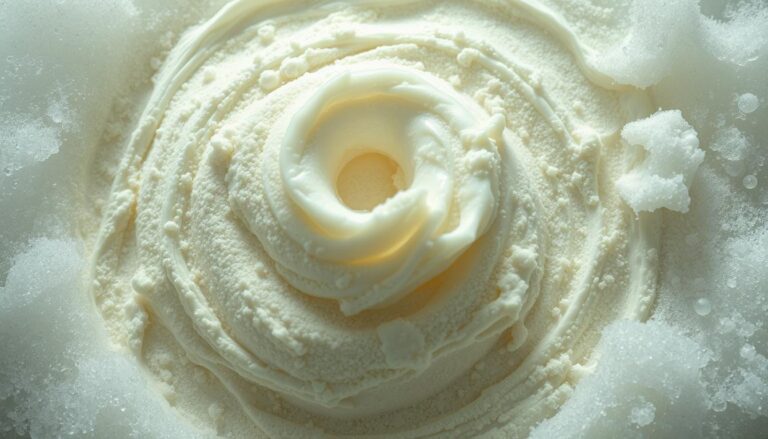What is the Difference Between a Regular Cleaning and a Deep Cleaning?

Americans spend six hours a week cleaning their homes. Yet, many don’t know the difference between regular and deep cleaning. This confusion is not just at home but also in dental care. People often wonder about regular versus deep dental cleaning. Knowing this difference can help keep both your home and teeth healthy.
Regular cleaning means keeping your place tidy by doing chores often. Similarly, in dental care, routine cleanings get rid of plaque and protect your teeth. But sometimes, a deeper clean is needed. Deep cleaning gets to hard-to-reach spots in your home and below the gumline in your mouth. It tackles problems that regular cleaning misses.
Knowing when to choose regular or deep cleaning is very important. It helps keep your home and teeth in top shape. Learning about these cleaning types is key for your health and your living space.
Key Takeaways
- Understanding the difference between regular and deep cleaning is crucial for good home and dental care.
- Regular cleaning takes care of everyday messes, while deep cleaning addresses tougher issues.
- Knowing when deep cleaning is needed can help avoid bigger problems later.
- Deep dental cleanings are important for preventing gum diseases.
- Choosing the right cleaning method affects your health, lifestyle, and wallet.
Understanding Regular Cleaning
Regular cleaning is key for keeping things hygienic both at home and in the dentist’s office. It lays the foundation to prevent bigger hygiene issues. When looking at standard cleaning versus deep cleaning, know that regular cleaning deals with everyday cleanliness and dental health, avoiding intense cleanups later.
In professional teeth cleaning, the goal is to get rid of plaque and tartar before they become big problems. This cleaning is simpler than a deep clean and doesn’t need anesthesia. This fact marks a clear professional teeth cleaning contrast with the more detailed treatments.
Being consistent with regular cleaning is crucial for oral hygiene. Brushing your teeth, flossing daily, and professional cleanings twice a year are advised. At home, regular cleaning means dusting, vacuuming, and mopping weekly to keep your space clean and healthy.
Let’s talk about what regular cleanings typically include:
- Dusting off surfaces to tackle daily dirt and allergens
- Cleaning floors by vacuuming carpets and mopping hard surfaces
- Disinfecting places you touch a lot, like doorknobs, countertops, and bathroom fixtures
- In dental care, it’s about cleaning the parts of teeth above the gum line for healthy gums and teeth
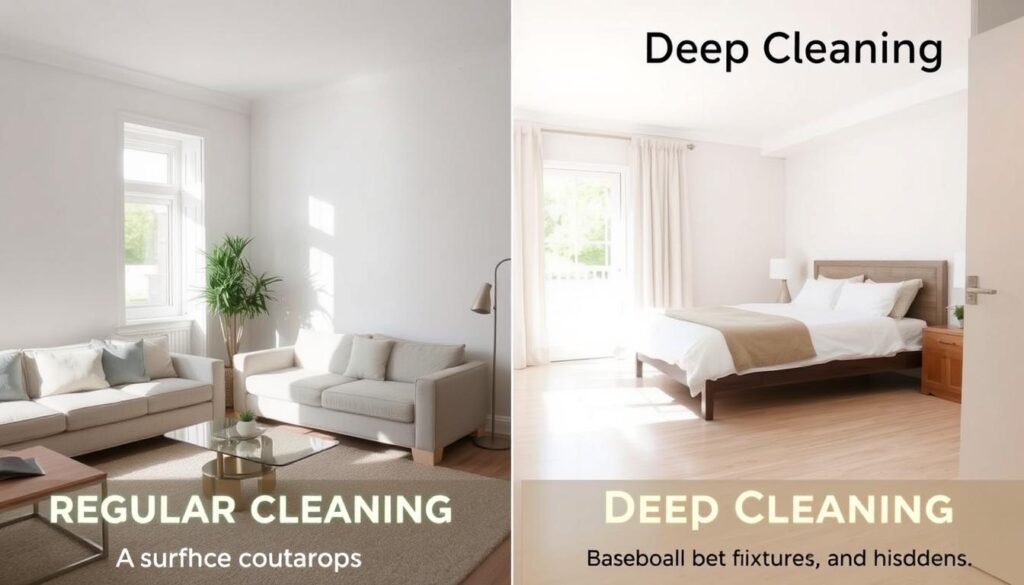
The right cleaning schedule is vital for success. Homes usually need a weekly clean, while the dentist suggests every six months for oral health. Regular dentist visits can catch decay and gum disease early.
Knowing the difference between regular and deep cleanings is important. Regular cleaning is about preventing major problems. Deep cleanings tackle more serious issues.
What Is Deep Cleaning?
Deep cleaning isn’t just a quick wipe down. It targets areas that don’t get much attention during regular cleaning. This detailed clean is a must for keeping homes and teeth healthy. It’s about understanding the oral health care cleaning difference between a normal clean and an oral hygiene deep clean.
In terms of dental health, deep cleaning is serious business. It includes steps like scaling and root planing for those with gum issues. By reaching below the gumline, it stops gum disease from getting worse, improving gum health.
When to deep clean varies. For homes, it might be when you’re moving or selling. For teeth, signs of gum disease or dentist advice during a check-up can lead to a deep clean.
Deep cleaning touches on things regular cleaning misses:
- Behind and underneath kitchen appliances
- Inside ovens and other cooking devices
- Cleaning air vents and ductwork
- Cleaning deep in periodontal pockets with scaling and root planing
Since it’s so thorough, deep cleaning takes more time and money than normal cleaning. This is due to the extra work and special tools needed.

The differences between regular and deep cleaning, in homes and dental care, show how vital deep cleaning is. It keeps cleanliness and health safety standards high.
Key Differences Explained
When looking at dental cleaning comparison techniques, it’s crucial to understand how routine vs deep dental cleaning differ. These differences greatly affect your oral health. We’ll check out how regular cleanings are not the same as the thorough clean you get with a deep cleaning.
The main difference is the level of detail of the cleaning. Routine cleanings deal with the surface. They remove plaque and tartar to stop common dental issues. But a deep cleaning goes further, cleaning gum pockets and roots to fight periodontitis.
Another big difference is how long the cleaning takes. A standard cleaning is fast, taking between 30 to 60 minutes. But a deep cleaning takes longer or might need several visits. This is because it’s more detailed and cleans areas routine cleanings miss.
The tools used in each cleaning also vary a lot. Routine cleanings use simple tools like brushes, scalers, and floss. Deep cleanings, however, might use advanced tools like ultrasonic scalers and lasers. These help remove plaque and bacteria from under your gumline.
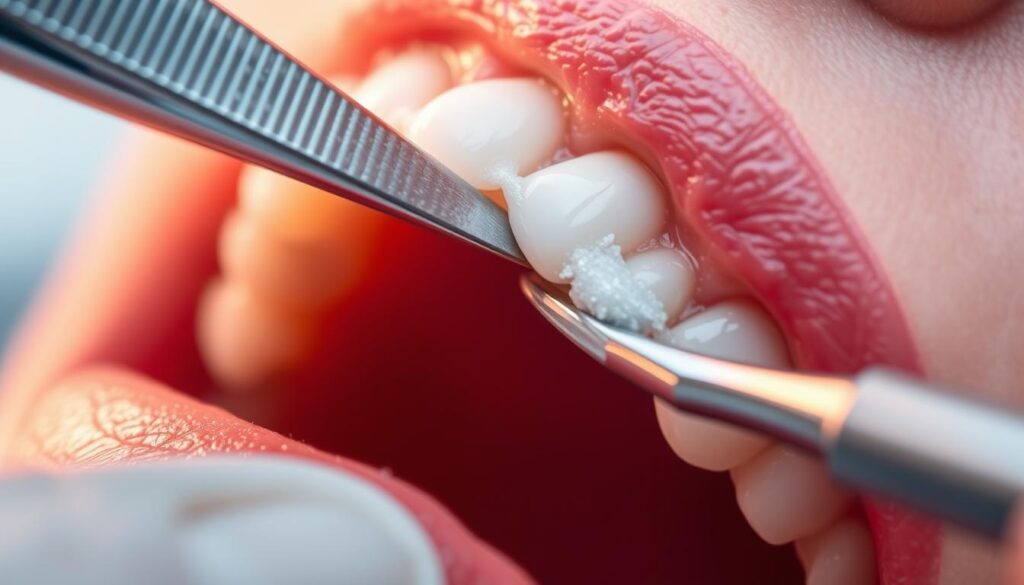
In conclusion, knowing these key differences helps you make smart choices about your dental care. By understanding these distinctions, dentists can offer the right treatments. They ensure each person gets the care their teeth and gums need.
Benefits of Regular Cleaning
Let’s talk about the pros of keeping a regular cleaning schedule. We’ll look at regular cleaning vs deep cleaning. These impact both our daily lives and how much money we spend. Regular cleaning is important for keeping our homes tidy and cost-effective.
Regular cleaning creates a clean, organized space. It makes us feel good and keeps our living areas healthy. You can find things easily, reduce clutter, and feel less stressed. This can make you more productive too.
It’s also about saving time and money. Regular cleaning is quicker because you do it often and know the tasks well. It takes less time than deep cleaning, which is perfect for busy people. Staying on top of cleaning saves money by avoiding damage and the need for deep cleans.
| Cleaning Type | Frequency | Cost | Scope |
|---|---|---|---|
| Regular Cleaning | Weekly/Bi-Weekly | Lower | Surface Level |
| Deep Cleaning | Bi-Annually | Higher | Comprehensive |
Similar to house cleaning, professional teeth cleaning contrast is interesting. Routine dental visits prevent big problems. They help avoid the need for costly, deep cleanings linked to serious gum diseases.

In the end, regular cleaning is key for both home and health. It stops problems before they start. This proactive habit improves our life, making our environments healthier and happier.
Advantages of Deep Cleaning
Deep cleaning reaches parts of your home that often get neglected. It plays a huge role in keeping your living space both clean and healthy. This type of cleaning is key for a good living environment.
It mainly helps by getting rid of allergens and bacteria and by making your home look better. Let’s look at these benefits more closely:
Elimination of Allergens and Bacteria: Deep cleaning is vital for a healthy home and for keeping everyone in it well. It removes harmful stuff from places that are hard to reach. This is just like in oral health, where deep cleaning can stop gum disease and keep your teeth.
Enhanced Home Aesthetics: A clean home is nicer to look at. It turns an average space into something welcoming and cozy. This can also help increase a home’s value or make it a nicer place to live.
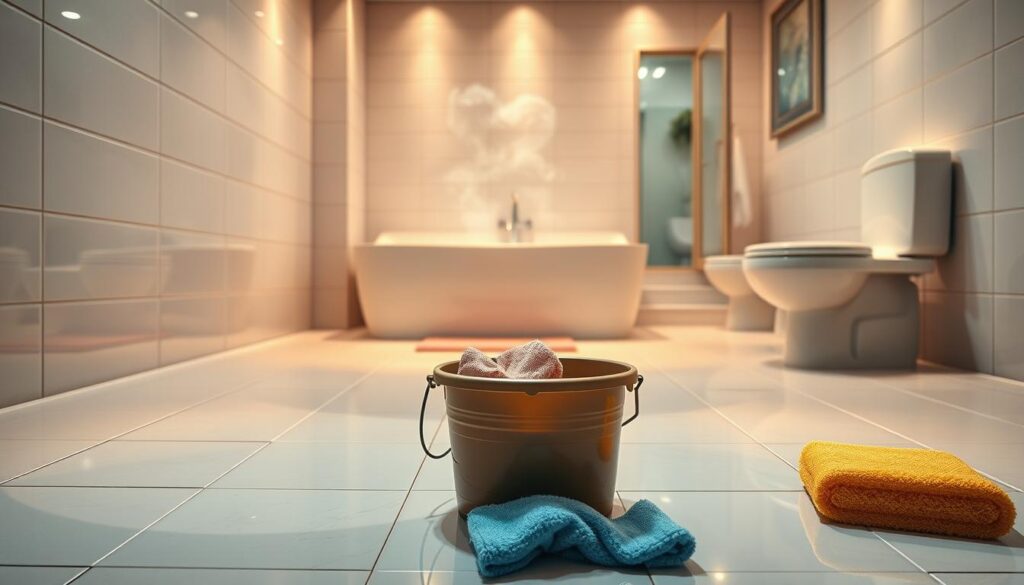
This table shows how regular and deep cleaning are different. It clearly presents why deep cleaning is better for improving your home.
| Feature | Regular Cleaning Impact | Deep Cleaning Impact |
|---|---|---|
| Allergen and Bacteria Removal | Surface level | Comprehensive, reaching deep layers |
| Aesthetic Enhancement | Moderate improvements | Significant transformation |
| Oral Health Care | Basic maintenance | Preventative care, essential for preventing oral diseases |
Which Type of Cleaning Is Right for You?
Choosing the best cleaning method for your home is important. It involves thinking about standard cleaning versus deep cleaning and the need for an oral hygiene deep clean. We’ll look at different factors to help you decide.
Assessing Your Cleaning Needs
Start by looking at your home’s current state. If it’s usually tidy and you clean often, standard cleaning should be enough. But, if you see lots of dust in hard-to-reach spots or it’s been a while since a good clean, consider a deep cleaning.
Lifestyle Considerations
The way you live affects your cleaning needs. Homes with kids, pets, or lots of visitors often need more cleaning. Also, deep cleaning can help remove allergens and bacteria, which is great for people with allergies or breathing problems.
Home Size and Layout
The size and design of your home also matter. Big houses, especially with many bathrooms and areas used often, usually need deep cleaning. Smaller homes might be fine with regular cleaning, especially if they’re easy to clean.

In the end, choosing between standard cleaning versus deep cleaning depends on personal and home factors. Thinking about these carefully ensures your home is not just clean but also healthy.
Regular Cleaning Tasks
Discussing regular cleaning vs deep cleaning means looking at normal tasks that keep areas neat. Unlike deep cleaning, regular cleaning doesn’t go as far but keeps things tidy on the surface.
In the kitchen and bathroom, keeping things clean is key for both hygiene and looks. Tasks include wiping counters, cleaning sinks, plus taking care of the stove and gadgets. For living rooms and bedrooms, dusting and vacuuming helps kick out daily dirt and allergens. This keeps the space fresh and welcoming.
- Dusting and Vacuuming: These methods are the core of regular cleaning. They cut down on allergens and make the air cleaner at home and work.
- Kitchen Tasks: Keeping this area neat means wiping surfaces, arranging things, and cleaning big appliances. This stops grime and food leftovers from gathering.
- Bathroom Tasks: Regular cleaning here means a good scrub of toilets, showers, and sinks. This is vital for staying healthy and feeling comfortable.
In talking about dental cleaning comparison, regular tooth cleanings stop tartar and plaque. It’s like how wiping surfaces stops dirt from piling up at home. Both activities are crucial for staying in good health.

Deep Cleaning Procedures
Deep cleaning goes deeper than normal cleaning. It targets the grime and bacteria that regular cleaning misses. This is important for both oral health care and keeping living spaces clean. Knowing the difference means understanding the tools and effort for a deep clean.
For keeping a home clean, deep cleaning means thorough sanitizing and getting rid of dirt. It’s key for a healthy living area. It tackles allergens and germs that build up over time, especially in spots that aren’t cleaned often.
- Steam Cleaning Carpets: This method cleans the surface and deep within the carpet. It gets rid of stubborn stains and bacteria, making carpets look new and last longer.
- Sanitizing Hard-to-Reach Areas: Cleaning spots like behind appliances and inside light fixtures is vital. It keeps the house clean and prevents harmful dust and mold buildup, protecting your breathing.
In dentistry, deep cleaning stops gum disease from getting worse. Using scaling and root planing removes bad plaque and tartar. This leads to healthier gums and stops teeth from falling out. The difference between regular and deep cleaning is clear in the better gum health and less swelling after these cleanings.
Deep cleaning is crucial for dental health and clean living spaces. It removes seen and unseen dirt, helping maintain health and wellness.
The Cost Comparison
When we talk about routine vs deep dental cleaning or regular cleaning vs deep cleaning of homes, money is a big part. Here’s a clear breakdown to show what each type costs. This info helps you see the money side of regular and deep cleaning.
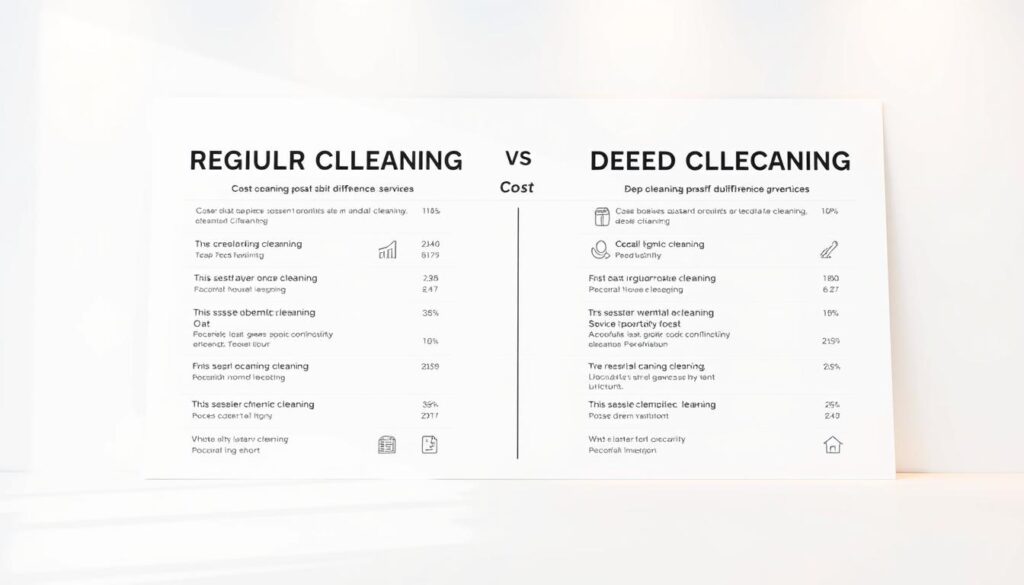
| Cleaning Type | Average Cost | Frequency Needed | Scope of Work |
|---|---|---|---|
| Regular Cleaning | $75 – $200 | Weekly/Bi-weekly | Surface cleaning, dusting, vacuuming |
| Deep Cleaning | $200 – $400 | Monthly/Quarterly | High-intensity cleaning, stain removal, deep sanitization |
| Deep Dental Cleaning | $150 – $350 | As recommended by dentist | Plaque removal, root planing, gum health restoration |
Pricing is usually based on how long and intense the cleaning service is. Regular cleaning is cheaper. It keeps places clean without going into deep details. But deep cleaning needs special skills and tools, so it costs more. In the case of teeth, deep cleaning is often pricier than routine. This is because it tackles gum disease and plaque with more care.
Frequency Recommendations
Knowing how often to clean your home and visit the dentist is key to staying healthy. We will look at the right times for both regular and deep cleans, and their benefits.
How Often Should You Schedule Regular Cleaning?
To keep spaces clean all the time, regular cleaning should happen every two weeks or month. This keeps everything up to standard and stops dust and dirt from piling up. If ignored, these can make a space look bad and unclean. When it comes to professional teeth cleaning, going twice a year is best to avoid dental issues and keep your mouth healthy. For more about dental cleaning, check out this resource.
How Often Should You Schedule Deep Cleaning?
Deep cleaning for homes and offices should be done every 6 to 12 months. It goes beyond regular cleaning by focusing on areas that aren’t usually addressed. The need for more frequent deep cleans can be influenced by the size of your space, if you have pets, or a lot of people coming and going. In the dental world, people with gum diseases may require more frequent deep cleans. Post-treatment, a deep clean every 3 months is important to fight off bad bacteria.
Choosing the correct times for standard cleaning versus deep cleaning ensures every part of your home, office, and mouth stays healthy. This prevents health issues and keeps things looking good and comfortable.
Using Professional Services
Like getting help for home repairs, dental care needs the touch of pros for cleaning teeth. Routine vs. deep dental cleaning both require someone skilled. Experts ensure your teeth get the best care, stopping problems before they start.
When it comes to tough issues, like deep dental cleaning, pros are a must. They dig deep to clear out plaque and tartar, which can cause major gum disease. They use special tools and their know-how to make the process safe and effective.
Choosing the right dental care, especially with complex tasks like cleaning teeth, is critical. Going with a trusted dental service means you get more than clean teeth. They look after your overall mouth health. In the dental cleaning comparison, each cleaning type has its place, but your mouth’s health decides which is right.
Going for either routine or deep cleaning, having a dental pro is key. They provide care that meets high standards. They tailor their approach for each person. This specialized attention stops future problems and keeps your teeth in top shape. This is like how professional cleaners ensure your home is spotless.
DIY Cleaning vs. Professional Services
Choosing between DIY cleaning and hiring professionals is a big decision. It affects cost, how well the job is done, and time spent. When we talk about keeping things clean, especially at dental offices, the difference is clear.
Do-It-Yourself (DIY) cleaning saves money and feels rewarding. People often feel their own cleaning is good enough without paying for help. Yet, deep cleaning, like in dental care, may not be as thorough with DIY.
Professional cleaning brings depth and know-how that DIY lacks. This matters a lot in hospitals and dental offices, where cleanliness affects patient health.
| Cleaning Type | DIY | Professional Services |
|---|---|---|
| Regular Cleaning | Cost-effective, time-consuming, less thorough | More expensive, efficient, thorough |
| Deep Cleaning | Limited by lack of specialized tools, potentially less effective | Uses advanced techniques and equipment, achieves higher cleanliness standards |
| Oral Health Care Cleaning | Basic maintenance like brushing and flossing | Professional cleaning to prevent diseases and maintain dental health |
The gap between DIY and professional cleaning is big, especially in health fields. While DIY handles basic cleaning, deep and dental care cleaning needs pros. This ensures the best hygiene and disease prevention.
Conclusion
Understanding the difference between standard and deep cleaning is key for a tidy home and good oral health. Everyday cleaning keeps your home orderly and manages basic dirt. On the other hand, a deep clean of your teeth fights plaque and bacteria, protecting your dental health well beyond daily brushing and flossing.
Similarly, deep cleaning your home tackles the spots you might miss in your regular routine. It makes your living area look and feel cleaner and healthier.
Making the Best Cleaning Choice for Your Home
Choosing the right cleaning for your home depends on a careful look at how you live. If your home is always busy, regular cleaning might be enough to keep things neat. But, getting a deep clean now and then removes deep dirt and allergens, making your home healthier.
Using both types of cleaning will help your home stay fresh and last longer.
Maintaining a Clean and Healthy Living Space
It’s very important to balance regular and deep cleaning for a clean, healthy home. This combo keeps your house clean every day and allows for deep cleaning when needed. This approach is good for your house and for keeping your mouth healthy, making sure you have both a nice-looking and healthy living space.


